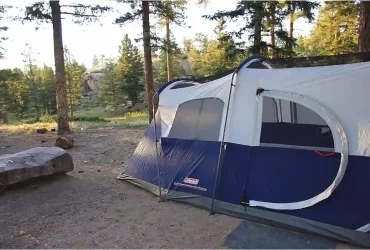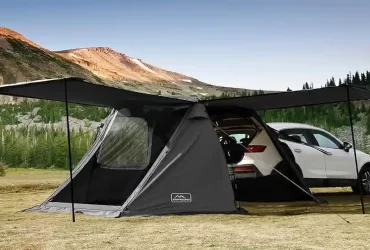Getting together around a campfire is a special experience. The temperature is warm and bright, making it a perfect place to roast marshmallows. But did you ever wonder, “How hot is a campfire? Not only is it hot, but it’s extremely hot!
It is possible for campfires to reach incredible temperatures that make our food cook and give us a sense of cozy warmth. Discover just how hot a campfire can get in this article about the fiery world of campfires.
We’re going to feel the heat and teach you something cool!
Factors Affecting Campfire Heat

Fuel Types
There are different heats associated with different types of wood.

- Softwood: A fire made from softwoods, such as pine or cedar, burns hotter than one from hardwoods, such as oak.
- Hardwood: Hardwoods burn longer and provide a consistent heat than softwoods, which allows for temperature control.
- Kiln-dried wood: Constructed by heating wood, it doesn’t release sparks and burns hotter than untreated wood, making it ideal for a campfire.
- Charcoal: Campfire cooking uses charcoal because it produces higher temperatures and less smoke than wood, which makes it a popular option.
- Pellet: It is composed of compressed sawdust and produces a clean and smokeless flame.
You need to choose the right wood for your project. Heat is directly proportional to the quality of the fuel. Your choice can have a significant impact on your campfire experience.
Oxygen Supply
To burn, you need oxygen, just as you need air to breathe. When there is plenty of oxygen in the campfire, it burns hotter and brighter. By blowing on or fanning their fires, campers are adding more air to them, which makes them grow stronger and warmer.
Fire Size
There is a great deal of importance to the size of a fire. It is possible to produce more heat with larger fires that use more wood. The difference between a small candle and a big bonfire can be explained as follows. Bonfires are always hotter than fireplaces. Adding wood will make you warmer, so add more!
Burn Duration
Burning wood can increase a fire’s temperature over time. The same is true for exercise; you start slowly and warm up as you go. During the coaling process, the wood becomes hotter, making the campfire perfect for cooking or heating.
Environmental Conditions
The role of Mother Nature is also important. Fires burn hotter in windy conditions. It is harder to start a fire if it is raining or damp. Depending on the weather and the surroundings, your campfire may be hot or cold. Don’t forget to keep an eye on the sky!
Also like this:
Campfire Temperature

It is important to start a fire as soon as possible. In the beginning, a campfire doesn’t have much heat. When the fire is just awakening, this is the best time to see it. Our mornings are like that; we start slowly and then become more energetic as the day progresses.
Sustained Flame Temperature
It takes some time for the fire to reach a steady heat once it gets going. A dance of flames makes the fire look bright and alive. There isn’t a lot of heat, but it is steady. In the fire’s words, “I am here and I am warm! ”
Peak Heat Output
As the campfire grows hotter, it becomes more intense. It’s a beautiful sight to see the wood burning brightly. Sitting close to the fire will make you feel the warmth. Taking that high note in a song is the fire’s big moment.
Heat Dissipation

Upon reaching its peak, the fire begins to cool down. Heat and flames become smaller as the fire burns. This is a sign that the campfire is ready for a rest. Don’t worry, it’s still warm enough outside.
Cooking Zone Temperatures
Using a campfire for cooking is a great idea. Fire has many parts, but they are not all the same. The edges of the room are cooler, so slow cooking is perfect. Grilling and searing can be done in the center, where it’s hottest. Having a good understanding of these zones will help you make tasty campfire meals!
Practical Campfire

The campfire isn’t just for fun; it’s a great kitchen as well! Grills and sticks are great for grilling marshmallows, burgers, and fish. Food is deliciously crispy on the outside and soft on the inside when it is heated. Keep in mind that the middle is the hottest part of the pan for quick cooking!
Campfire Warmth
How cold is the night? Camping with a fire is no problem! It emits warmth during chilly nights, making them more comfortable. No matter what you’re doing, the warmth of the fireplace ensures that you’re comfortable. As if you were holding a big, warm, light blanket.
Heat For Survival
Having a campfire is extremely helpful if you’re lost in the woods. You stay warm and protected from the cold with the warmth of the heat. A smoke and light signal can also be used to request assistance. When things get tough, fire is the best friend you can have.
Melting And Boiling

Are you in need of hot water? It may be possible to help with a campfire. Melting snow or boiling water is possible with the right heat. Whether you’re making hot drinks or cleaning, it’s convenient. As far as melting metal is concerned, campfires have you covered.
Light And Insects
The light of a campfire illuminates the night during the dark hours. It provides campers with better visibility and keeps them safe. The majority of bugs dislike smoke. In addition to keeping mosquitoes at bay, a campfire can also keep them at bay. There’s nothing like walking into a bright, bug-free zone!
Also like this:
Safety Measures

Fire Safety Basics
Despite the warmth and joy that campfires bring, they should always be treated with the utmost safety. The location you choose must be far from trees and tents. Be prepared by always having some sand or water handy. By doing so, you are better prepared to respond quickly to an unexpected spark or flame.
Keep a Safe Distance
It is natural for people to gather around campfires due to their radiant glow. While enjoying its warmth, keep a respectful distance to avoid getting hurt. Similarly, it’s smart to stay away from a hot campfire in order to ensure a safe, enjoyable experience.
Supervision Guidelines
In spite of its mesmerizing appeal, a campfire should never be left unattended. Assume that it is a playful pet that occasionally misbehaves. Keeping an eye on the flames should always be the responsibility of someone, ready to intervene at any moment. In this way, everyone around us is assured of a safe environment.
Fire Extinguishing Methods
After putting the campfire to sleep for the night, it’s imperative to properly put it out. It is best to use plenty of water, followed by sand or dirt, to ensure that every ember is extinguished. In the same way that you want to ensure a child is safe and sound before tucking them in at night.
Leave No Trace Principles
A natural environment is our playground, and we should treat it as such. The campfire must be cleaned up after the last embers have cooled, making sure no traces remain. As a result, next adventurers will be able to discover the same untouched beauty you were able to enjoy.
Also like this:
Conclusion
When we sit near its burning, warm flames, this is a question many of us ask ourselves. Getting to know what makes it hot and how it can be used safely is fascinating.
In addition to providing light and warmth, campfires provide a lot more. Cooking, keeping us warm, and even protecting us from bugs are some of the things they do for us. However, safety should always take precedence.
Sharing stories and making memories around the campfire is a great time to learn more about this delightful friend of the outdoors. Remember to stay safe during all the fiery moments!
FAQs
What Factors Determine The Temperature Of A Campfire?
A campfire’s temperature is determined by the type of fuel used, the amount of oxygen available, the size of the fire, the burn duration, and the surrounding climate. There are different factors that contribute to the heat or cold of the fire.
Is Campfire Heat Suitable For Cooking Various Foods Safely?
It is safe to cook food over a campfire. Various dishes can be prepared from simmering to searing if one understands the fire’s zones. You just need to make sure that the food is cooked thoroughly so that it is safe and delicious.
How do I put out my campfire?
There is a simple way to extinguish your campfire. Using a shovel, stir the ashes until all ashes are covered with water. Continue to sprinkle water until no steam is rising from the fire. To speed up cooling, spread the remaining embers around with a stick or shovel; don’t forget to remove any chunks of wood left in the pit, as they might rekindle when exposed to heat or wind later.





Leave a Reply
View Comments